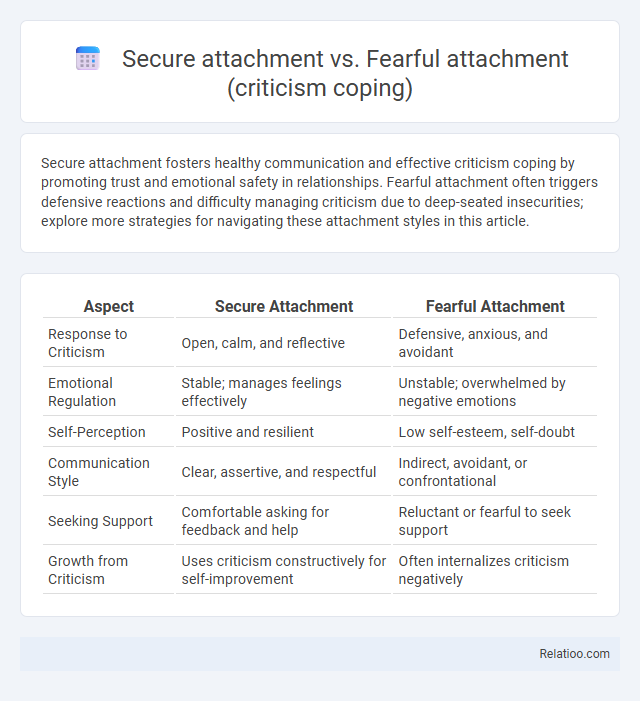Secure attachment fosters healthy communication and effective criticism coping by promoting trust and emotional safety in relationships. Fearful attachment often triggers defensive reactions and difficulty managing criticism due to deep-seated insecurities; explore more strategies for navigating these attachment styles in this article.
Table of Comparison
| Aspect | Secure Attachment | Fearful Attachment |
|---|---|---|
| Response to Criticism | Open, calm, and reflective | Defensive, anxious, and avoidant |
| Emotional Regulation | Stable; manages feelings effectively | Unstable; overwhelmed by negative emotions |
| Self-Perception | Positive and resilient | Low self-esteem, self-doubt |
| Communication Style | Clear, assertive, and respectful | Indirect, avoidant, or confrontational |
| Seeking Support | Comfortable asking for feedback and help | Reluctant or fearful to seek support |
| Growth from Criticism | Uses criticism constructively for self-improvement | Often internalizes criticism negatively |
Understanding Attachment Styles: Secure vs Fearful
Secure attachment fosters healthy emotional regulation and effective criticism coping by encouraging trust and open communication, enhancing Your resilience to negative feedback. Fearful attachment, characterized by anxiety and avoidance, complicates criticism processing, often triggering defensiveness or withdrawal that hinders personal growth. Understanding these attachment styles aids in developing emotional awareness and improving interpersonal relationships through adaptive coping mechanisms.
Core Characteristics of Secure Attachment
Secure attachment is marked by trust, emotional openness, and confidence in relationships, enabling individuals to effectively cope with criticism by viewing it as constructive feedback rather than personal attack. In contrast, fearful attachment combines a desire for closeness with anxiety and avoidance, leading to heightened sensitivity to criticism and difficulty managing negative feedback. Core characteristics of secure attachment include emotional resilience, balanced self-esteem, and a stable internal working model of others as reliable and supportive.
Key Traits of Fearful Attachment
Fearful attachment is characterized by a deep desire for closeness combined with a fear of rejection and intimacy, leading to ambivalent and avoidant behaviors. Individuals with this attachment style often experience heightened anxiety and difficulty trusting others, impairing their ability to cope effectively with criticism. In contrast, secure attachment promotes confidence in relationships, resilience to negative feedback, and healthier emotional regulation when facing criticism.
Emotional Regulation in Securely Attached Individuals
Secure attachment enhances your emotional regulation by promoting consistent self-soothing and stress management strategies, leading to healthier responses during criticism. In contrast, fearful attachment often triggers heightened emotional reactivity and difficulty processing feedback due to underlying anxiety and avoidance. Securely attached individuals typically use constructive coping mechanisms, enabling them to maintain emotional balance and resilience when facing criticism.
Coping with Criticism: Secure Attachment Responses
Secure attachment fosters healthy coping with criticism by promoting emotional regulation and balanced self-esteem, allowing you to process feedback without defensiveness. Individuals with secure attachment view criticism as constructive, using it to enhance personal growth and improve relationships. Unlike fearful attachment, which can trigger anxiety or avoidance, secure attachment encourages open communication and resilience in handling negative evaluations.
Fearful Attachment and Sensitivity to Criticism
Fearful attachment is characterized by high sensitivity to criticism, often triggering intense emotional distress and defensive responses that hinder effective coping strategies. Unlike secure attachment, which promotes resilience and constructive processing of negative feedback, individuals with fearful attachment struggle to regulate emotions and may internalize criticism as a threat to self-worth. This heightened sensitivity can exacerbate interpersonal conflicts and undermine personal growth by fostering avoidance and mistrust in relationships.
Behavioral Reactions: Secure vs Fearful Attachment
Individuals with secure attachment typically exhibit calm and constructive behavioral reactions when facing criticism, responding with openness and a willingness to engage in self-improvement. In contrast, those with fearful attachment often display defensive or avoidant behaviors, such as withdrawal, denial, or heightened emotional distress, which hinder effective coping with criticism. Securely attached individuals leverage emotional regulation and trust in relationships to process feedback healthily, whereas fearful attachment triggers anxiety and self-doubt that disrupt adaptive responses.
Impacts on Relationships and Communication
Secure attachment fosters open communication, emotional responsiveness, and trust, leading to healthy conflict resolution and stronger bonds in relationships. Fearful attachment often results in avoidance of criticism, heightened anxiety, and difficulty expressing emotions, which impairs effective communication and creates misunderstandings. These contrasting attachment styles significantly influence relational stability and the ability to cope with negative feedback.
Overcoming Fearful Attachment Patterns
Overcoming fearful attachment patterns involves developing emotional regulation and building trust through consistent, supportive relationships, which contrasts with the innate stability found in secure attachment. Individuals with secure attachment typically exhibit effective criticism coping by interpreting feedback as constructive, whereas those with fearful attachment often respond with heightened sensitivity or avoidance due to underlying anxiety. Therapeutic interventions and mindful communication strategies can foster secure attachment qualities, enabling better resilience to criticism and healthier interpersonal connections.
Developing Secure Attachment for Healthier Criticism Coping
Developing secure attachment is crucial for healthier criticism coping as it fosters self-confidence and emotional regulation, allowing you to respond to feedback without undue fear or defensiveness. Individuals with secure attachment view criticism as constructive, while those with fearful attachment often interpret it as a threat, triggering anxiety and avoidance behaviors. Cultivating secure attachment patterns involves building trust, emotional openness, and resilience, which transform criticism into opportunities for personal growth rather than sources of distress.

Infographic: Secure attachment vs Fearful attachment (criticism coping)
 relatioo.com
relatioo.com